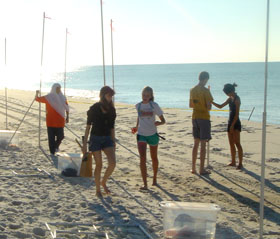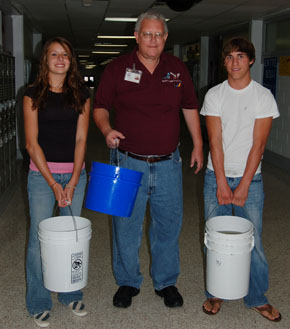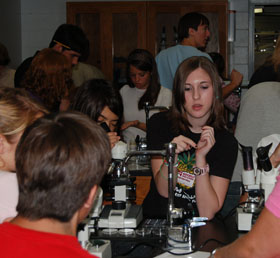
Student Researchers to Present at Kyoto Scientific
Conference
Thursday, September 28, 2006 ![]()
 A large group of student scientists methodically collected samples of coast dwelling organisms at Henderson Beach Park Tuesday. |
 The students carefully marked the transect lines 5 meters apart. They used GPS locators to ensure that the measurements were accurate and that they will remain the same year-to-year. |
 Jason Baker, Maryam Mohammed and Maria Rossi team up to catalogue and photograph all the different species of marine life found at Henderson the day before. |
 Rick Hernandez helps students Ann Durrenberger and Jacob Burns carry the waste water out of the lab. He is excited about the students' opportunity to collaborate with prestigious scientists from around the world. |
 Considerable organization is required to coordinate such a large group of student scientists. Each table represents one of the five transect lines. The analysis and photographs took a full day of work by about 30 students and teachers. |
The lab is abuzz with activity and the sound of students talking excitedly as they peer through their microscopes, checking for different species of marine micro-organisms.
They hurry over with their slides and hand them to Niceville High School senior Maria Rossi, who is busily cataloguing every slide onto an Excel spreadsheet, before passing them on to junior Maryam Mohammed, who lines them up in order and photographs the samples.
Mohammed is serious and professional, emanating an air of calm while maintaining intense focus on her work. Her quiet smile contrasts with the energetic grin of senior Jason Baker, whose flair for the organizational and promotional aspects of the project led him to assume the role of spokesperson for the group. The students are not merely studying science; they are working as scientists, conducting research as part of an important world-wide tracking study of the marine life found in coastal areas.
The NaGISA (Natural Geography of
In-Shore Areas) project originated at
One of the NHS presentations will discuss the scientific aspects of the study, explaining how the research was conducted and how the procedures were adapted to the local environment, with its powdery beaches. According to District curriculum specialist Shawnea Tallman, the original protocol was for rocky shore analysis, but Niceville’s enthusiastic insistence on participating in the study and its leadership in recruiting other institutions led to the opening up of the protocol to include sandy substrates this year.
The second presentation will focus on the considerable organizational requirements, which has so far involved assistance from the underwater crime unit of the Sheriff’s Department, state park and Coast Guards personnel, Navy Explosive Ordinance Divers and many community supporters, such as the Sloan Foundation.
“We all have our own specialty,” explains Baker, who plans on majoring in business next year. “I’m the one who does the fund-raising and represents us to the community. Maria is the computer whiz and Maryam can tell you anything about science. She’s really brilliant, but she’s shy.”
Baker is particularly happy
with the level of respect the teachers show for the students, working side
by side with them, rather than lecturing from a podium. “They're like
college professors,” he says. “They ensure we follow procedures correctly,
but they let us manage the process.”
Gifted instructor Rick Hernandez
visited
Tuesday, a large group of students
took water and sand samples from 25 different areas at
Last spring, Niceville invited a
team from
That collaboration will be extended
to include recruitment this year. When the Niceville students return from
![]()
Related Files
:
Related Articles
:
No Related Content
Found